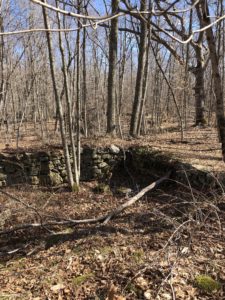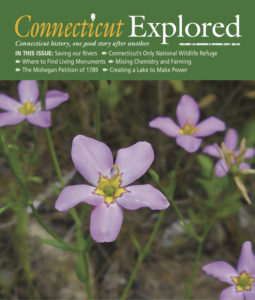(c) Connecticut Explored Inc. Spring 2021
Subscribe/Buy the Issue!
When I was a kid my family visited Yosemite National Park and we all bought the park’s t-shirts emblazoned with sayings such as (complete with punctuation) “Go climb a rock.” and “Go for a hike.” Well, springtime is here, so go for it (to use a more contemporary idiom)!
But before you head out, read this issue, which explores Connecticut’s historic landscape—a theme we return to again and again because it is such a rich topic. In this issue we’re focusing on the environment: the surroundings and conditions in which Connecticans have lived and that have shaped our state over time, particularly with respect to human impact on those surroundings.
It’s surprising to me how soon after colonial settlement that the newcomers’ human impact was felt—and conservation efforts were attempted. [See “Fish, Game, and Forest Conservation Through Time, page 46.] Of course our scientific understanding of the natural world has evolved over time, and several stories in this issue explore that development.
Though much in our environment has been lost forever, some loss has been slowed, mitigated, or even reversed. After Connecticut ended the practice of destroying salt marshes in the 1960s, for example, loss of this important buffer between land and sea continues due to rising sea levels. [See “Our Historic Salt Marshes,” page 34.] The return of several animal species nearly extirpated from the state by the 18th century is one example of a reversal: beavers, deer, bear, and wild turkeys have returned to what some might call a nuisance level. The water quality in our rivers and sound is better today than 150 years ago, and, despite urban and suburban sprawl, more of the state is forested today than 200 years ago.

Cellar hole in The Preserve in Westbrook, Essex, and Old Saybrook. The 963-acre forest is said to be the largest coastal forest between Boston and New York.
All of which is to say that as you get out on our state’s 800 miles of historic trails, look for the history around you: abandoned cellar holes and stone walls deep in the woods tell you that at one time you would have been traversing open farm fields. In the 1920s and 1930s volunteers blazed 250 miles of those trails. Read about the Mattabesett and Metacomet trails in Christine Woodside’s “Connecticut’s Historic Trails” (Summer 2008). Visit our new TOPICS page, ctexplored.org/landscape-environment, for all of our stories about Connecticut’s historic landscape. You won’t have any excuse not to “Take a hike!”
What’s New?
Visit page 58 to see a list of our 2020-2021 Friends of Connecticut Explored who contributed $100 or more through December 31, 2020 to help keep us publishing! I am always so heartened by these gifts, some of which come with personal messages, and many of which come from long-term, loyal subscribers and friends. We welcome your gifts any time of the year.
We are also grateful to our loyal Organizational Partners—the museums and historical societies that partner with us. Please take a look at their messages in this (and every) issue and patronize them in person or virtually. Undoubtedly you’re a member of one or two. Why not pick a new one to get to know this year? I assure you, you’ll be rewarded with fascinating opportunities to learn something new about our state, and our nation’s, fascinating history.
NEW E-CTEXPLORED! Watch for your e-mail with your member-subscriber all-access password to the NEW e-CT Explored! We’ve switched to a new format that makes it easier to read the latest issue on your phone or tablet. It’s handy when you’re waiting for a doctor’s appointment and have forgotten to bring your print copy along.
Connecticut Explored uncovers the state’s cultural heritage with the aim of revealing connections between our past, present, and future. For stories from our back issues visit ctexplored.org.
Go to Next Story
Go Back to Spring 2021 Issue
Subscribe/Buy the Issue!

